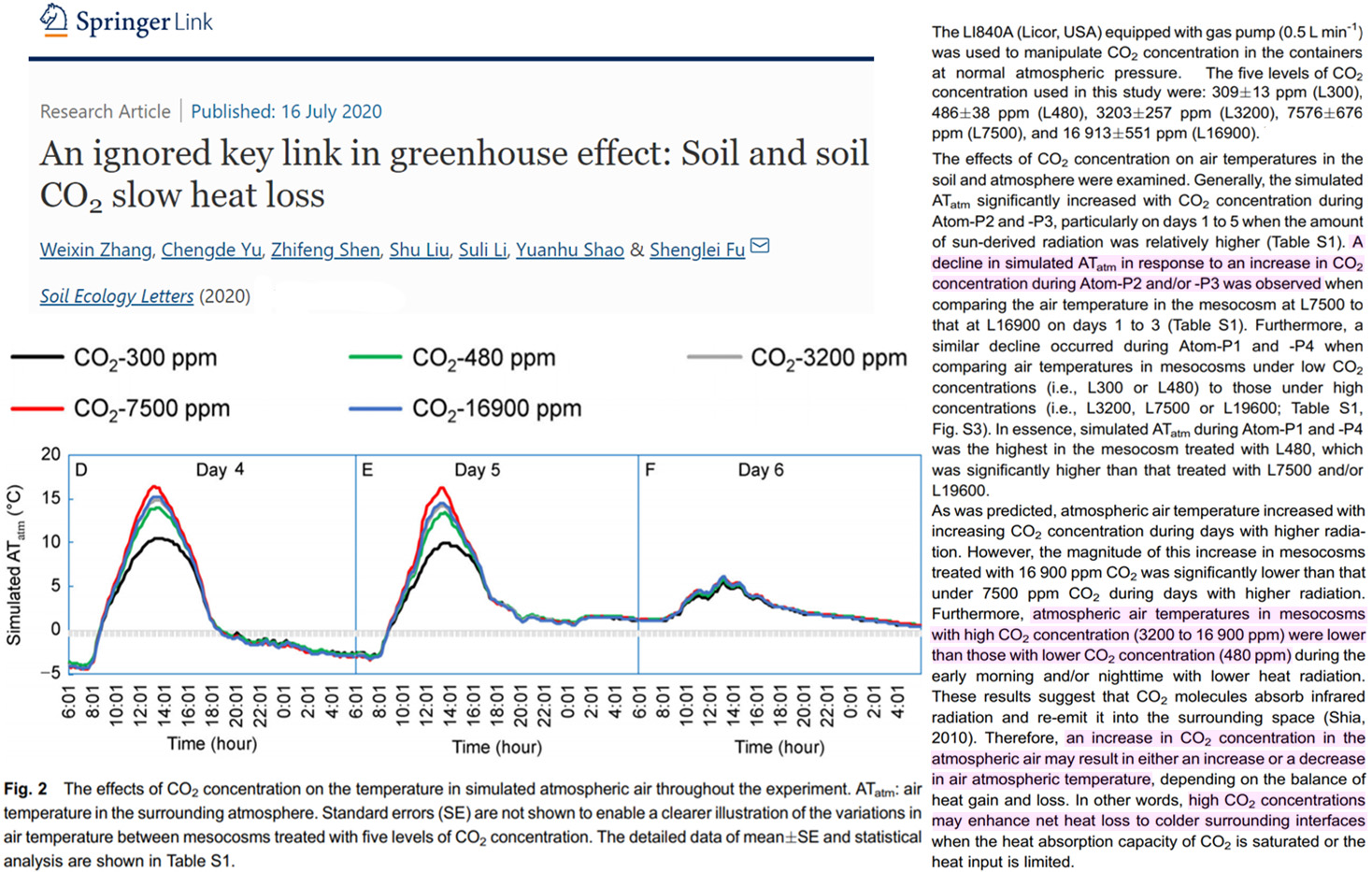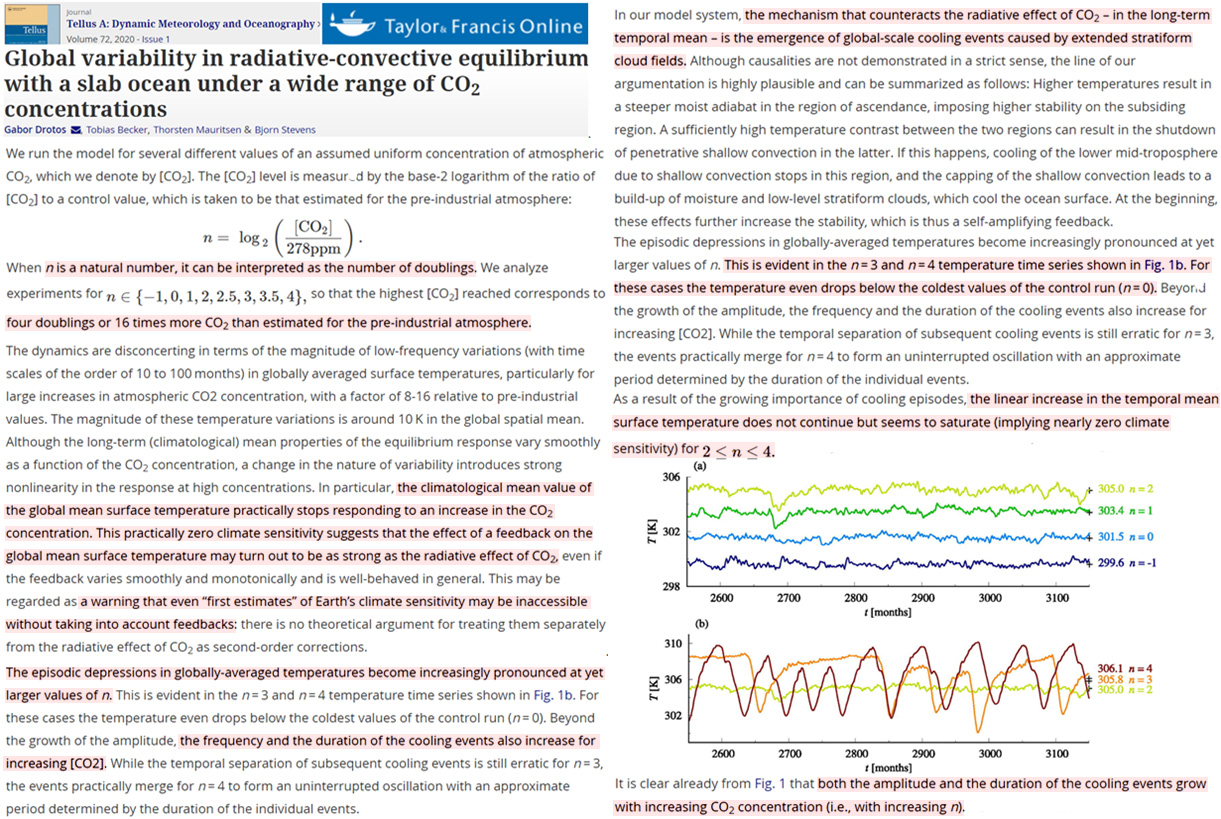A 2020 observational study (Zhang et al., 2020) determined “temperatures of atmospheric air with substantially higher CO2 concentration (ranging from 3200 ppm to 16,900 ppm) were lower than that with the lower CO2 concentration (480 ppm)” and a 2020 modeling study (Drotos et al., 2020) assessed that when CO2 goes beyond 4 times preindustrial – 1,120 ppm – “climate sensitivity decreases to nearly zero” because the climate cyclically cools by 10 K.
So the science is settled, right?

Image Source: Zhang et al., 2020 (abstract) (pdf)






Kenneth, are you sure you aren’t misinterpreting the studies?
The authors of the first study write in the abstract that “The ever-increasing atmospheric CO2 concentration is a key driver of modern global warming,” and the study itself looks at SOIL CO2 concentrations.
They also write that “While it would be not relevant to examine the effect of extremely high CO2 concentrations on air temperature in the atmosphere, soil CO2 concentration can be as high as 20 000 ppm (Hirano et al., 2003; Wang et al., 2011; Sheng et al., 2012), hence our chosen range of CO2 levels was deemed appropriate.”
Seems like the authors assume the greenhouse effect is valid, and that their study is not looking at such concentrations in terms of atmosphere, but in terms of soil.
Correct. The authors affirm their we-believe-in-AGW credentials in the abstract. Then, in the observations from the experiment itself, they point out that cooler temperatures were associated with the higher CO2 levels in the atmospheric air half of the experiment, and thus “CO2 with substantially higher concentration may enhance the net heat loss”.
Correct. That’s why the title of this article is that observational (this one) studies show temperature falls as CO2 rises. Temperatures were lower with 16,900 ppm atmospheric CO2 and higher with 480 ppm CO2. This would not appear consistent with expectations that CO2 rise drives temperature rise.
But you’re right about there being a contradiction between rising CO2 being a key contributor to atmospheric warming of the Earth when this phenomenon is not observed in this experiment.
But they did consider atmospheric air. It was half of their mesocosm experiment. The other half pertained to soil CO2. The results were similar: temperatures rise as CO2 falls. Or, as the graph shows, they often are about the same, meaning the CO2 concentration has no significant effect.
Doug Lightfoot has a new paper that comes to the same conclusion
http://thelightfootinstitute.ca/imglib/IPCC-3-errors-CO2.pdf
The direct contributions of soil and soil CO2 to the greenhouse effect should be recognized.
Weixin
Thanks for posting!
It makes sense that soil is important and overlooked.
It is enlightening and not so surprising to know that soil has more heat capacity than the atmosphere.
But there are no photon interactions to speak of within mostly dark soil so how does CO2 have any warming effect there?
Phil,
Thanks for the response!
CO2 in soil plays a similar role as in the atmosphere,i.e., absorbing and re-emitting the long- wave radiation. Thereby, soil CO2 may contribute to retaining heat (slow heat loss) by repeatedly exchanging heat with soil particles, but at the same time, soil CO2 may enhance the soil heat flux towards surface atmosphere by re-emitting long-wave radiation. Both the two processes would affect heat balance of surface earth.
Weixin
One more comment.
Your innovative hypothesis that soil is a cause, not effect, of CO2 warming, could solve some paradoxical observations relating to glaciation.
At the end of recent Pleistocene glacial intervals, CO2 rises rather than falling.
Looking further back, there is good palaeo evidence that as the glaciation at the end of the Ordovician era ended more than 400 million years ago, CO2 levels also rose significantly.
Sorry for no references – I can find these if needed.
(The end-Ordovician glaciation is perplexing to orthodox scientists due to high CO2 levels that pertained.)
But ice cover is the same as concrete – it cuts off the soil from the air. So with spreading glaciation soil could no longer influence atmospheric temperature.
Your soil hypothesis seems compelling and it’s ability to solve other questions such as glaciation effects would only make it stronger.
correction
glaciation at the end of the Ordovician era ended
I meant as the glaciation at the end of the Ordovician era spread, i.e. at it’s beginning, not end.
This is all very confusing. One wild idea might be that under a quiet sun the polar vortex expands, leading to stagnant air over the high latitudes, resulting in colder temperatures and a lack of those noctilucent clouds. But south of the vortex things might well get warmer.